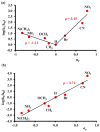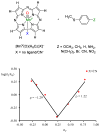Singlet versus Triplet Reactivity in an Mn(V)-Oxo Species: Testing Theoretical Predictions Against Experimental Evidence
- PMID: 27545752
- PMCID: PMC5228574
- DOI: 10.1021/jacs.6b05027
Singlet versus Triplet Reactivity in an Mn(V)-Oxo Species: Testing Theoretical Predictions Against Experimental Evidence
Abstract
Discerning the factors that control the reactivity of high-valent metal-oxo species is critical to both an understanding of metalloenzyme reactivity and related transition metal catalysts. Computational studies have suggested that an excited higher spin state in a number of metal-oxo species can provide a lower energy barrier for oxidation reactions, leading to the conclusion that this unobserved higher spin state complex should be considered as the active oxidant. However, testing these computational predictions by experiment is difficult and has rarely been accomplished. Herein, we describe a detailed computational study on the role of spin state in the reactivity of a high-valent manganese(V)-oxo complex with para-Z-substituted thioanisoles and utilize experimental evidence to distinguish between the theoretical results. The calculations show an unusual change in mechanism occurs for the dominant singlet spin state that correlates with the electron-donating property of the para-Z substituent, while this change is not observed on the triplet spin state. Minimum energy crossing point calculations predict small spin-orbit coupling constants making the spin state change from low spin to high spin unlikely. The trends in reactivity for the para-Z-substituted thioanisole derivatives provide an experimental measure for the spin state reactivity in manganese-oxo corrolazine complexes. Hence, the calculations show that the V-shaped Hammett plot is reproduced by the singlet surface but not by the triplet state trend. The substituent effect is explained with valence bond models, which confirm a change from an electrophilic to a nucleophilic mechanism through a change of substituent.
Conflict of interest statement
The authors declare no competing financial interest.
Figures









Similar articles
-
A Balancing Act: Stability versus Reactivity of Mn(O) Complexes.Acc Chem Res. 2015 Oct 20;48(10):2754-64. doi: 10.1021/acs.accounts.5b00273. Epub 2015 Sep 9. Acc Chem Res. 2015. PMID: 26352344 Free PMC article.
-
Significant effect of spin flip on the oxygen atom transfer reaction from (oxo)manganese(V) corroles to thioanisole: insights from density functional calculations.Phys Chem Chem Phys. 2012 Oct 5;14(37):12800-6. doi: 10.1039/c2cp41647f. Phys Chem Chem Phys. 2012. PMID: 22874974
-
Hydrogen atom abstraction by a high-valent manganese(V)-oxo corrolazine.Inorg Chem. 2006 Jun 26;45(13):5119-25. doi: 10.1021/ic060491+. Inorg Chem. 2006. PMID: 16780334
-
Manganese-Oxygen Intermediates in O-O Bond Activation and Hydrogen-Atom Transfer Reactions.Acc Chem Res. 2017 Nov 21;50(11):2706-2717. doi: 10.1021/acs.accounts.7b00343. Epub 2017 Oct 24. Acc Chem Res. 2017. PMID: 29064667 Review.
-
Valence-tautomerism in high-valent iron and manganese porphyrins.J Biol Inorg Chem. 2001 Oct;6(8):831-45. doi: 10.1007/s007750100277. J Biol Inorg Chem. 2001. PMID: 11713691 Review.
Cited by
-
Second Coordination Sphere Effects on the Mechanistic Pathways for Dioxygen Activation by a Ferritin: Involvement of a Tyr Radical and the Identification of a Cation Binding Site.Chembiochem. 2022 Jul 5;23(13):e202200257. doi: 10.1002/cbic.202200257. Epub 2022 May 23. Chembiochem. 2022. PMID: 35510795 Free PMC article.
-
What Drives Radical Halogenation versus Hydroxylation in Mononuclear Nonheme Iron Complexes? A Combined Experimental and Computational Study.J Am Chem Soc. 2022 Jun 22;144(24):10752-10767. doi: 10.1021/jacs.2c01375. Epub 2022 May 10. J Am Chem Soc. 2022. PMID: 35537044 Free PMC article.
-
Bridging the Homogeneous-Heterogeneous Divide: Modeling Spin for Reactivity in Single Atom Catalysis.Front Chem. 2019 Apr 16;7:219. doi: 10.3389/fchem.2019.00219. eCollection 2019. Front Chem. 2019. PMID: 31041303 Free PMC article.
-
Quantum Mechanics/Molecular Mechanics Studies on the Relative Reactivities of Compound I and II in Cytochrome P450 Enzymes.Int J Mol Sci. 2018 Jul 6;19(7):1974. doi: 10.3390/ijms19071974. Int J Mol Sci. 2018. PMID: 29986417 Free PMC article.
-
Does Substrate Positioning Affect the Selectivity and Reactivity in the Hectochlorin Biosynthesis Halogenase?Front Chem. 2018 Oct 30;6:513. doi: 10.3389/fchem.2018.00513. eCollection 2018. Front Chem. 2018. PMID: 30425979 Free PMC article.
References
-
-
See, e.g.: Solomon EI, Brunold TC, Davis MI, Kemsley JN, Lee SK, Lehnert N, Neese F, Skulan AJ, Yang YS, Zhou J. Chem Rev. 2000;100:235–349.Bugg TDH. Curr Opin Chem Biol. 2001;5:550–555.Ryle MJ, Hausinger RP. Curr Opin Chem Biol. 2002;6:193–201.Costas M, Mehn MP, Jensen MP, Que L., Jr Chem Rev. 2004;104:939–986.Abu-Omar MM, Loaiza A, Hontzeas N. Chem Rev. 2005;105:2227–2252.Bruijnincx PCM, van Koten G, Klein Gebbink RJM. Chem Soc Rev. 2008;37:2716–2744.Kryatov SV, Rybak-Akimova EV, Schindler S. Chem Rev. 2005;105:2175–2226.
-
Publication types
MeSH terms
Substances
Grants and funding
LinkOut - more resources
Full Text Sources
Other Literature Sources

